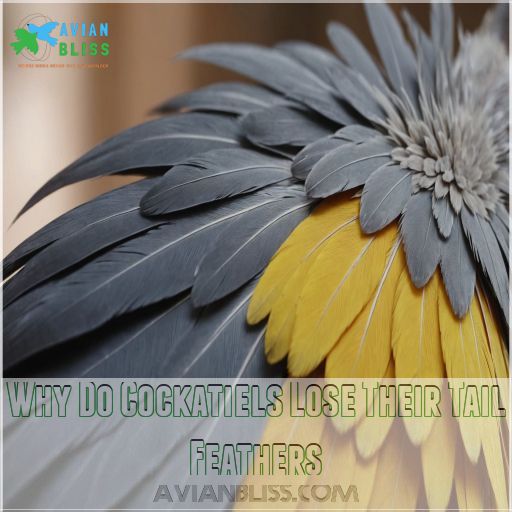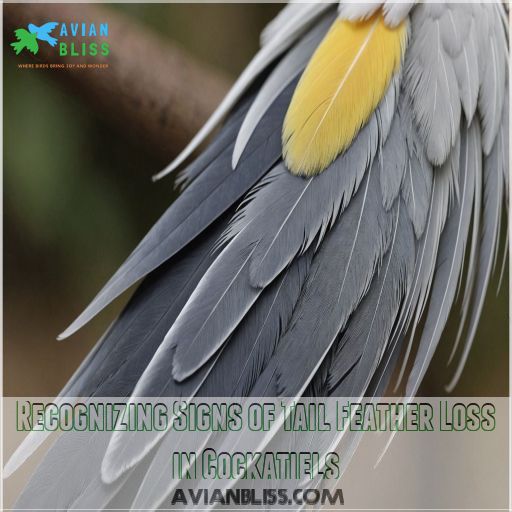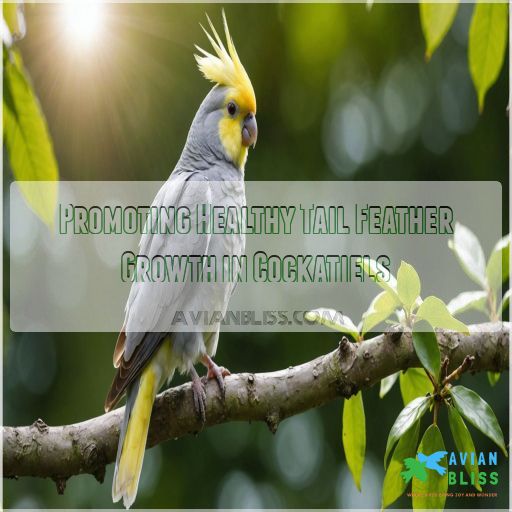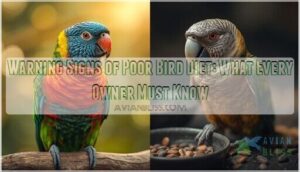This site is supported by our readers. We may earn a commission, at no cost to you, if you purchase through links.
 Yes, a cockatiel’s tail feathers can grow back, so don’t fret if your feathered friend loses a few!
Yes, a cockatiel’s tail feathers can grow back, so don’t fret if your feathered friend loses a few!
Tail feathers naturally molt every six months or so, but poor diet, stress, or a cramped cage can slow regrowth.
To help your cockatiel flaunt a feather-tastic tail again, offer a balanced diet with extra calcium and make sure they live stress-free in a spacious cage.
Think of it as crafting a VIP feather spa! Just like us needing a chill spot and good food to thrive, they do, too.
Ready to learn more avian secrets to keep your cockatiel chirpy and bright?
Table Of Contents
- Key Takeaways
- Can Cockatiels Grow Back Tail Feathers
- Why Do Cockatiels Lose Their Tail Feathers
- Recognizing Signs of Tail Feather Loss in Cockatiels
- Promoting Healthy Tail Feather Growth in Cockatiels
- Common Misconceptions About Cockatiels’ Tail Feathers
- Caring for a Cockatiel With Tail Feather Loss
- Frequently Asked Questions (FAQs)
- Can a bird’s tail feathers grow back?
- Is it normal for cockatiels to lose tail feathers?
- How long does it take for a bird to grow feathers back?
- How long does it take for a cockatiels crest to grow back?
- How does environment affect tail feather regrowth?
- What role do genetics play in feather regrowth?
- Why may molting affect feather texture changes?
- Do tail feather types influence regrowth speed?
- How do hormonal changes impact feather regrowth?
- Conclusion
Key Takeaways
- Don’t worry if your cockatiel loses a few tail feathers—they’ll grow back with the right care! Focus on a balanced diet rich in calcium, much like giving them a nutritious feather makeover.
- Keep stress at bay by offering a spacious cage and a tranquil environment. Your feathery friend needs a VIP birdie retreat where they can feel like a feather-flaunting celebrity.
- Be on the lookout for signs of illness—if feather loss or strange behavior persists, consult a vet. Think of it as calling in the experts to make sure your cockatiel stays in tip-top shape.
- regular vet check-ups and engaging toys help foster a healthy lifestyle, ensuring your cockatiel’s tail feathers return better than ever, ready to show off in any avian fashion show!
Can Cockatiels Grow Back Tail Feathers
If you’re worried about your cockatiel’s tail feathers growing back, you’re not alone; it’s a common concern for bird owners.
Tail feather regrowth depends on factors like diet, calcium intake, and stress, so let’s make sure your feathered friend gets the best care possible!
Factors Affecting Tail Feather Growth
Consider your cockatiel’s cozy cage size and balanced diet—they’re the secret sauce for healthy tail feather regeneration.
Feather quality depends on stress levels and feather growth rate.
If your bird is feeling tense or its diet’s off, feather growth might slow down.
Remember, age can also play a role in feather loss and regeneration, but patience is key.
Importance of Calcium for Feather Growth
Calcium is essential for your cockatiel’s feather growth and overall health.
A calcium deficiency can make it tough for new feathers to grow in properly after molting or damage.
Supplement their diet with cuttlebone or eggshell powder to make sure they’re getting enough.
With the right nutrients, those tail feathers will be back in no time!
Role of Diet in Promoting Tail Feather Growth
A well-balanced diet is key to boosting your cockatiel’s tail feather growth! Don’t wing it; make sure they get sufficient calcium, vitamins, and minerals to support those feather follicles through all growth stages.
Keep an eye on:
- Nutritional deficiencies that could clip their feathered ambitions
- Cockatiel behavior for dietary adjustments
- Varied foods to keep mealtime fun and healthy
Environmental Factors Affecting Tail Feather Growth
To help your cockatiel’s tail feathers grow back strong, keep their environment just right. Subtle changes in cage size, humidity levels, and light exposure can work wonders. Imagine you’re their feather growth guru, balancing air quality and temperature like a maestro. Avoid stressful situations—feathers don’t thrive on drama!
Check out the table below for environmental tips:
| Factor | Impact on Feathers | Ideal Condition |
|---|---|---|
| Cage Size | Space to Move | Spacious |
| Humidity Levels | Prevent Dryness | 50-60% |
| Light Exposure | Natural Growth | 10-12 hours of light |
| Air Quality | Healthier Feathers | Clean, fresh air |
Why Do Cockatiels Lose Their Tail Feathers
You might find your cockatiel looking a bit punk rock with missing tail feathers, but don’t worry—it’s probably more common than you think!
From molting to mischief, these feather losses can happen for a variety of reasons,
and understanding them can help you better care for your feathered friend.
Molting and Feather Replacement
Cockatiels naturally molt every 6 months, shedding old feathers and growing new ones.
During this time, all feathers, including tail feathers, will be replaced.
The process can be stressful, so provide extra support and a peaceful environment.
Feathers regrow at different rates depending on the stage of the molt, so be patient as your cockatiel’s tail feathers fill back in.
Feather Plucking and Its Causes
Molting may be normal, but when your feathery friend starts looking like it’s having a "bad feather day," feather plucking could be the culprit. Stress, boredom, and health issues like hormonal imbalances might cause this behavior.
Make sure you provide a stimulating environment, balanced diet, and mental engagement to keep those beautiful tail feathers intact.
Remember, a happy cockatiel is less inclined to disrobe!
Disease and Infection Leading to Tail Feather Loss
Every now and then, feather loss in cockatiels can be caused by disease or infection.
When facing this issue, keep an eye out for:
- Bacterial or fungal infections
- Parasite infestations
- Viral infections like proventricular dilatation disease
These culprits can stall feather growth, change feather color, and affect whether cockatiels’ tails grow back smoothly. Keep your feathered friend in good health!
Accidental Tail Feather Pulling and Its Impact
Accidental tail feather pulling can ruffle more than just a cockatiel’s feathers—it may impact balance and cause stress.
Safeguard child safety by supervising interactions and teaching gentle handling tips.
Although feather regrowth is on the horizon, a young cockatiel needs a tranquil environment to heal.
Keep an eye out for infection risk to make sure your bird’s health is okay.
Stress and Its Effect on Tail Feather Loss
Stress can take a toll on your cockatiel’s feathers. When birds feel anxious or overwhelmed, they may start plucking out their own tail feathers. This not only looks unsightly, but it can also lead to infections and other health issues.
To help, create a calm, enriching environment and watch for signs of distress, such as:
- Excessive preening or feather-pulling
- Changes in appetite or sleep patterns
- Increased aggression or withdrawal
- Lethargy or lack of energy
Recognizing Signs of Tail Feather Loss in Cockatiels
You’ll know your cockatiel is losing tail feathers if you catch them looking a bit disheveled, like they just rolled out of bed!
Keep an eye out for signs of infection or changes in your bird’s behavior, as these could indicate underlying issues.
Identifying Broken or Damaged Feathers
Identifying broken feathers amid molting can feel like a wild goose chase, but knowing the types helps. Broken feathers look frayed or bent.
A feather inspection checklist keeps it simple:
| Feather Damage | Description | Action Needed |
|---|---|---|
| Frayed | Rough edges | Monitor closely |
| Bent | Unnatural angles | Wait till molt |
| Split | Parted shaft | Provide support |
| Missing | Gone entirely | Boost nutrition |
Monitoring for Signs of Infection or Disease
Spotting damaged feathers is step one.
Now we’re onto monitoring for infection or disease.
You know what they say: a stitch in time saves nine!
Look for these signs:
- Redness around feathers – it shouldn’t look like a sunset.
- Swollen feather shafts – as puffy as a marshmallow? Bad news.
- Abnormal feather growth – feathers shouldn’t zig-zag!
Changes in Behavior and Stress Levels
Your cockatiel’s behavior may change if it’s losing tail feathers.
Look for signs of stress, like increased aggression, feather plucking, or withdrawal.
Provide a calm, enriching environment and a balanced diet to help your feathered friend stay relaxed during this molting period.
With patience and care, those tail feathers will grow back in no time.
Impact on Balance and Flight Capabilities
Losing tail feathers can throw your cockatiel off balance faster than a wobbly seesaw.
Without their full plumage, flying can seem like getting around a maze blindfolded.
Watch for flight difficulties, like crash landings or clumsy turns.
Here’s the flight path to recovery:
- Provide perches at various heights.
- Encourage gentle exercise.
- Maintain a safe landing area.
Promoting Healthy Tail Feather Growth in Cockatiels
To help your cockatiel grow back its beautiful tail feathers, you’ll need to focus on providing a balanced diet rich in calcium and maintaining a stress-free environment.
Just like you wouldn’t want to be crammed into a tiny space, ensuring a properly sized cage can also make all the difference in their feather regrowth!
Providing a Balanced Diet for Feather Growth
Just imagine your cockatiel’s diet like a vibrant palette of colors—each morsel adding to the masterpiece of healthy plumage.
Mixing cockatiel food with seed mix and vegetable supplements makes sure they get the necessary vitamins they need.
Toss in some greens and fruits occasionally.
This nutritional harmony supports not just their tail feathers but also brings out their dazzling personality!
Ensuring Adequate Calcium Intake
Making sure your cockatiel gets enough calcium is really important for healthy feather growth.
Sprinkle some crunchy cuttlebone onto their food, or grind up dried eggshells into a powder and mix it in.
Don’t forget a vitamin D3 supplement too – it helps their body absorb that all-important calcium.
Creating a Stress-Free Environment for Cockatiels
Apart from calcium, peace and quiet support your cockatiel’s feather growth.
To keep things calm:
- Offer quiet time daily, making the cage a refuge.
- Use a variety of toys for mental stimulation—life can’t be all work and no play!
- Make sure perches are safe: no splinters or wobbly spots.
- Add bird-safe plants for that extra touch of zen.
Maintaining Proper Cage Size and Setup
Choosing the right cage size is really important for your cockatiel’s feather health.
Always make sure there’s enough room to spread its wings without bumping into toys, food bowls, or water bowls.
Secure perches at various levels for easy tail swishing.
Remember, a bird cramped in a small cage hasn’t got space to flaunt its plumage. It’s like living in a shoebox!
Importance of Regular Health Monitoring
A spacious cage is a step toward a healthy lifestyle for your cockatiel.
But like a detective keeping early detection in mind, regular health monitoring is key to preventative care.
Schedule vet visits to spot any trouble before it starts.
Think of it as your cockatiel’s passport to happiness—after all, it’s about disease prevention, not correction!
Common Misconceptions About Cockatiels’ Tail Feathers
There are a few common misconceptions about cockatiels’ tail feathers that are important to address.
For instance, the belief that cockatiels need to be around other cockatiels for their tail feathers to regrow is simply not true.
Myth-Busting: Cockatiels Need Other Cockatiels to Grow Tail Feathers
Don’t fall for the tall tale that your solo cockatiel needs a buddy to grow its tail feathers!
Cockatiels are independent little fluff balls.
Whether they’re mingling or flying solo, they regrow tail feathers just fine.
Remember these tips:
- Socialization: It’s optional, not essential.
- Feather Growth: It depends on health, not company.
- Myths Debunked: Enjoy your independent growth!
Excessive Plucking and Its Consequences
While myths surround cockatiel feather regrowth, plucking is more serious. Plucking’s no joke—stress and boredom are common culprits. If your cockatiel’s pulling out feathers, it’s trying to tell you something about its health. Take a look!
| Issue | Cause | Prevention |
|---|---|---|
| Stress | Changes | Calming space |
| Boredom | Isolation | Interactive toys |
| Health | Malnutrition | Balanced diet |
Importance of Proper Handling and Supervision
Speaking of plucking, let’s talk about handling your feathered friend. Cockatiels and kids? Like oil and water without supervision. To keep harmony:
- Child Safety: Teach gentle touch.
- Bird Interaction: Set boundaries.
- Supervision Tips: Always keep an eagle eye.
- Preventing Accidents: Move slow, go low.
These steps help your cockatiel’s feathers stay intact.
Caring for a Cockatiel With Tail Feather Loss
If your cockatiel has lost some tail feathers, don’t worry – with the right care, those lively plumes can grow back.
By providing a quiet, comfortable environment and offering extra support, you can help your feathered friend through this change.
Providing a Quiet and Comfortable Environment
A peaceful environment is key in helping your cockatiel recover from tail feather loss. Consider cage size and choose one spacious enough for comfort.
Engage in noise reduction by placing the cage in a quiet space.
Splurging on soft bedding choices and safe toys might just make your cockatiel feel like it’s living in the birdie version of a luxury resort!
Offering Support and Reducing Stress
Giving your cockatiel a soothing environment rocks their world!
A quiet space filled with cage enrichment and safe playtime toys can ease their stress.
Share positive interactions, and make sure their healthy diet is on point.
Much like people, cockatiels thrive on love and care—it’s their feathered freedom ticket.
With your support, they’ll feel like themselves in no time.
Seeking Professional Veterinary Care When Necessary
Even if your cockatiel’s feather loss seems minor, a vet checkup can be a game-changer. Think of it as having the pros in your corner! They’ll help rule out bird health issues and infection risks.
- Observe unusual behavior.
- Notice feather loss timing.
- Spot persistent health problems.
- Avoid self-medicating your bird.
- Seek professional advice during emergencies.
Preventing Future Tail Feather Loss
While the recovery process may seem tough, preventing future tail feather loss in your cockatiel is key. Make sure their cage is the right size, provide enrichment toys to reduce stress, and feed a balanced diet rich in calcium. Gentle handling and close supervision are also important to safeguard your feathered friend’s well-being.
| Cage Size | Stress Management | Toy Choices | Diet Impact |
|---|---|---|---|
| Adequate | Calming elements | Varied | Calcium-rich |
| Spacious | Soothing music | Foraging | Supplements |
| Clutter-free | Quiet location | Interactive | Balanced |
| Comfortable | Positive reinforcement | Rotating | Nutritious |
Frequently Asked Questions (FAQs)
Can a bird’s tail feathers grow back?
Yes, birds can regrow their tail feathers, but it takes patience like the Resplendent Quetzal.
During molting, old feathers are shed, and new ones grow in about 4-6 weeks.
Proper care and nutrition help healthy regrowth, giving birds their flamboyant tails back.
Is it normal for cockatiels to lose tail feathers?
It’s totally normal for cockatiels to break their tail feathers from time to time.
Don’t sweat it – those lively little tails will grow back good as new in just 4-6 weeks with proper care.
How long does it take for a bird to grow feathers back?
Feathers usually regrow in a few weeks to several months, depending on factors like species, health, and environment.
It’s like waiting for a haircut to grow out—patience pays off as those feathers return in style!
How long does it take for a cockatiels crest to grow back?
Imagine this: a cockatiel’s crest, your bird’s crown jewel, takes around 6 to 8 weeks to grow back.
Provide quality nutrition and a stress-free environment for your feathery friend to help speed up the regrowth process.
How does environment affect tail feather regrowth?
Your cockatiel’s environment plays a big role in tail feather regrowth.
A stress-free, spacious cage with stimulating toys encourages rapid growth.
Stressors or cramped conditions can slow the process, leaving your feathered friend feeling plucked and helpless.
What role do genetics play in feather regrowth?
Genetics play a big role in how quickly your cockatiel’s tail feathers grow back.
Some birds are simply blessed with faster feather regeneration, so don’t fret if yours takes a bit longer.
Why may molting affect feather texture changes?
Molting can change feather texture because new feathers might be softer or have a different structure.
It’s like swapping old shoes for a new pair—initially unfamiliar, but eventually, they fit into the routine perfectly.
Do tail feather types influence regrowth speed?
Tail feather types don’t hold the key to regrowth speed, but diet and overall health do.
Keep the cage welcoming, feed proper nutrients, and voila!
You’ll see a cockatiel flaunting its gorgeous new tail feathers in no time.
How do hormonal changes impact feather regrowth?
Over 60% of feather regrowth issues in birds tie to hormonal imbalances.
If your cockatiel seems more "ruffled" than usual, stress or breeding changes may stall those new tail feathers.
Keep calm and consult a vet if needed!
Conclusion
Ultimately, with the right care and attention, your cockatiel’s tail feathers can regrow to their former glory.
By providing a balanced diet, ample space, and a stress-free environment, you’ll have your feathered friend flaunting a full, vibrant tail in no time.
So don’t despair if your cockatiel loses a few tail feathers – with your help, those tail feathers can grow back, and your cockatiel can once again strut their stuff.









